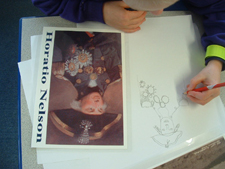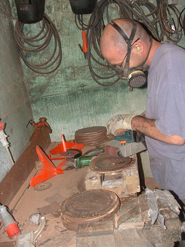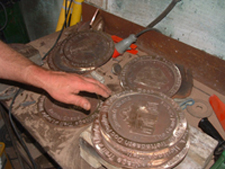
Llwybr Treftadaeth Doc Penfro – Pembroke Dock Heritage Trail
|
||
| 1.
Y ‘Carmarthenshire’- The ‘Carmarthenshire’
(Library) The Library, which was built on land once tidal, was opened in 1987. Water Street, the road that separates the library and the police station was once called Shore Street, a reminder of the extent of the original tidal pill. It was here that many ships were built, including the merchant ship ‘Carmarthenshire’ that was constructed in 1865. It was the first such ship to enter the Japanese harbour of Yokohama. As well as its cargo of Cardiff coal, the ship carried with it the first Western females to be seen by the Japanese population. Soon after the Captain’s wife and his daughter set foot on land, images of European fashions appeared on a range of oriental tableware. |
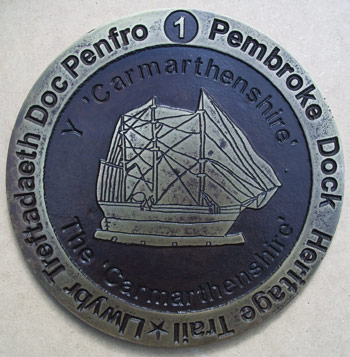 |
|
|
|
||
| 2.
Yr Adeilad Pwmpio - The Pump House This quirky red-bricked building stands in the centre of the roundabout leading to Western Way. Although originally built to pump sewage from the town to the Dockyard, it was never actually used for this function. It was found completely unnecessary to have such a pumping system! In its time, this elegant building has been used as a meeting house and a church. |
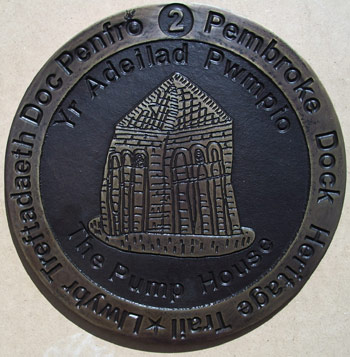 |
|
|
|
||
| 3.
Sioe Orllewin Gwyllt Byffalo Bill - Buffalo Bill’s Wild
West Show It’s difficult to imagine that one of the greatest entertainers of the late 19th Century visited this dockyard town, but Buffalo Bill certainly did! The spectacular Buffalo Bill Wild West Show was brought to this spot on May 14th 1903. The show, a massive tableau of the Wild West, containing over 500 horsemen, began its performance with a procession from Pembroke Railway Station to this site in Bierspool. This was led by the showman himself, William F. Cody, otherwise known as Buffalo Bill. Among the star attractions was a range of horsemanship featuring Native Americans, sharp shooting exercises and various displays featuring South American gauchos, Bedouin tribesmen and Russian Cossacks. |
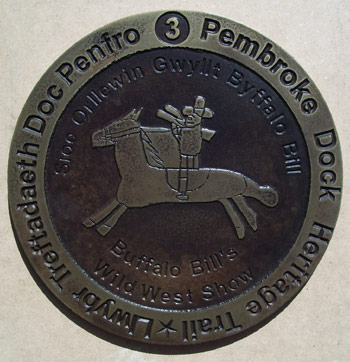 |
|
|
|
||
| 4.
Mynwent Filwrol Llanion - Llanion Military Cemetary Few people realise that this is the only Military Cemetery in Wales. It is the last resting place of servicemen and their relatives who were killed or died while serving in the Garrison town. Concealed within the Llanion housing estate, this really is one of Pembroke Dock’s ‘hidden treasures! Look out for row of seventeen graves towards the south of the graveyard. These are the graves of soldiers who died in an accidental explosion while practising the techniques of disarming mines. The incident occurred on 28th April 1942. The men killed were nine Royal Engineers, four men from The King’s Own Scottish Borderers and four who were serving with The Pioneer Corps. An incredible footnote – one officer escaped certain death that day when he chose to leave the tragic scene to answer the telephone! |
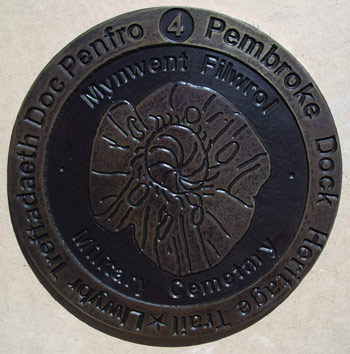 |
|
| |
||
| 5.
Y Gwersyll Cytiau - The Hut Camp This was once the home to Hut Camp, later known as Llanion Barracks. Originally these barracks, which could house anything up to 1000 men, were built in only six weeks! Infantry regiments from all over the country have occupied these barracks. The red-bricked barracks we see standing today were built later in 1906. During the Second World War, American GIs of the 110th US Infantry Regiment were based here and this led to a visit from the Supreme Allied Commander, General Dwight D. Eisenhower who arrived here in at Llanion in 1944. Recently, this impressive structure served as the main offices for South Pembrokeshire District Council. |
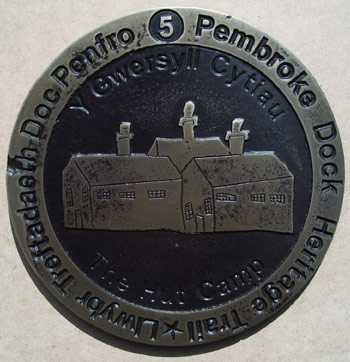 |
|
| 6.
Hobbs Point – Hobbs Point Hobbs Point was built by apprentices in 1829 as a ‘Fitting Out’ area for ships that were built in the Dockyard. They used a diving bell to lay the foundations. When Telford’s road system from St Clears was completed in 1837, Pembroke Dock became a post town and, as such, became an important point for the movement of mail to and from Ireland and Great Britain. Prior to the building of The Cleddau Bridge, a car ferry operated between Hobbs Point and Neyland. |
 |
|
| 7. Cae Ffair – Fairground
In days gone past,
here on ‘Watery Meadows’, Fun fairs and horse racing
events were held here. |
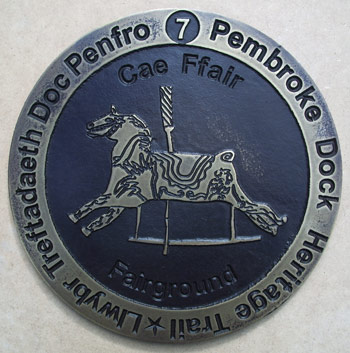 |
|
| 8. Stryd Flaen–
Front Street When
you walk down Front Street, take a close look at numbers 25 to
28 as these are reputed to be the first houses that were built
in Pembroke Dock. Much has changed and it is difficult to believe
that this relatively short street once housed seven public houses
to serve the hundreds of thirsty dock workers! Women from Llangwm
would supplement this by steering their boats in this direction
in order to sell a range of fish. |
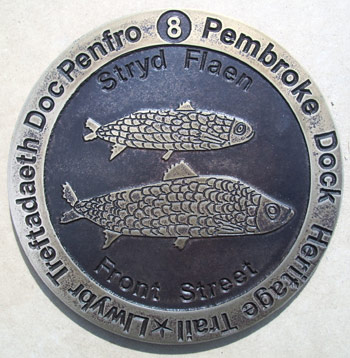 |
|
| 9. Amgueddfa
Twr y Gwn – Guntower Museum This
impressive stone structure, built in 1849 – 50 at a cost
of £9,230, is situated at the western end of Front Street.
This ‘Cambridge’ Gun Tower is one of only seven in
the world, of which seven are to be found in the Haven. Originally
built to repel foreign fleets, it is now the town’s museum
and is definitely worth a visit. |
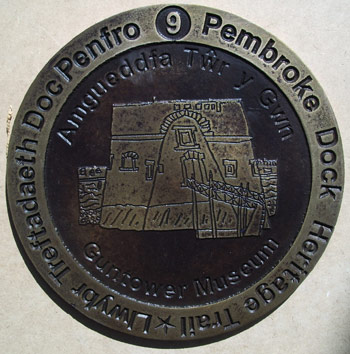 |
|
| 10. Arwydd Lloches
Rhag Bomiau – Air Raid Shelter Sign No
longer a chemists, this quaint building at the end of Commercial
Row is an excellent example of an early 20th Century shop front.
It was the backdrop for a number of scenes of the popular television
programme, The Onedin Line. |
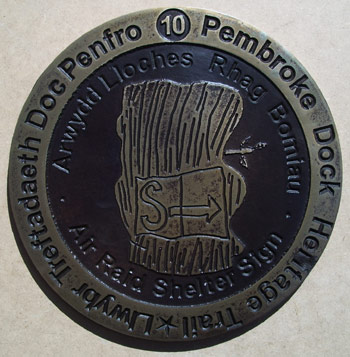 |
|
| 11.
Capel Y Garsiwn – Garrison Chapel Then
Garrison or Dockyard Chapel, built in 1831, is considered to be
the only Classical Georgian church in Wales. |
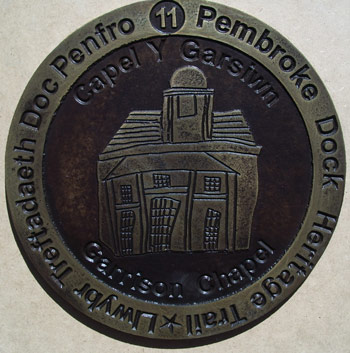 |
|
| 12. Awyrennau
Môr ‘Sunderland’ – Sunderland Flying Boats
In 1930, a major
part of the dockyard was transferred from the Admiralty to the
Air Ministry. The following year, the Royal Air force established
a seaplane base, operated by Southampton flying boats of 210 squadron.
1938 saw the arrival of the squadron’s first Sunderland
flying boats – the aircraft that Pembroke Dock is most associated.
During the second World War the Sunderlands fulfilled the important
role of protecting British Convoys from the German Navy. |
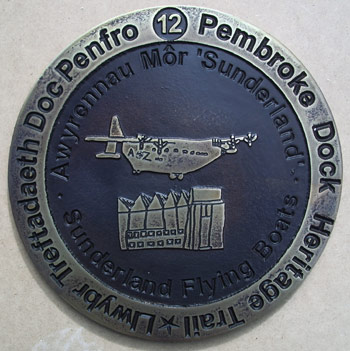 |
|
| 13. Terfynfa’r
Fferi – Ferry Terminal Ireland
is only a four-hour journey from the ferry terminal here in Pembroke
Dock. The ferry taking you there is the Isle of Innishmore and
it is the second largest passenger ferry in Europe. |
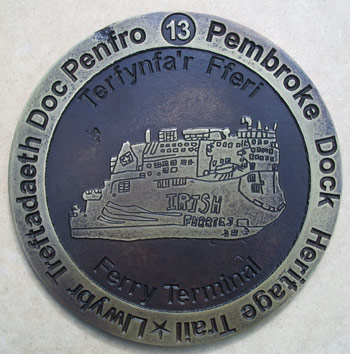 |
|
| 14. Yr Iard
Longau Lyngesol Frenhinol – Royal Naval Dockyard
At its peak in the 1890’s, the Royal Dockyard
was one of the largest in the world, employing over 3,000 people.
Over 250 Royal Navy vessels and five royal yachts have been built
here over the years. Pembroke Dock can boast many firsts as it
built the first steam man-of-war, HMS Tartar and the first propeller-driven
warship, HMS Conflict. |
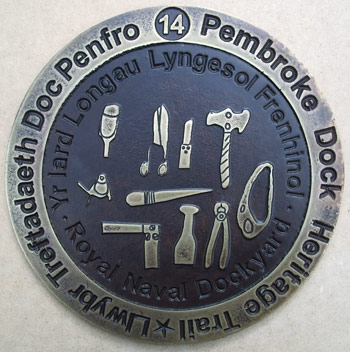 |
|
| 15. Twr Paterchurch
– Paterchurch Tower
Dating back to at least the 13th Century, this
is the oldest building in Pembroke Dock. A fine example of a first
floor hall tower, there is uncertainty over its original purpose.
We know that it was once owned by the knights of St John of Jerusalem.
Was it a church, look-out tower or farm? Perhaps it was a combination
of all three. Certainly the case for it being a church was strengthened
when the walls of the dockyard were extended in 1844. This led
to the discovery of an old burial ground next to the tower. |
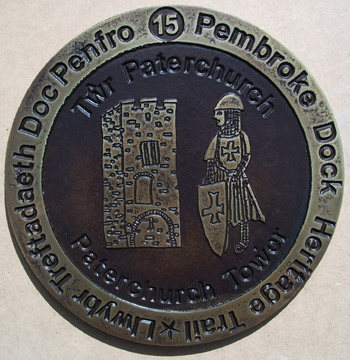 |
|
| |
||
| 16. Rasys Beiciau Peni-ffardding – Penny Farthing Bike Races | 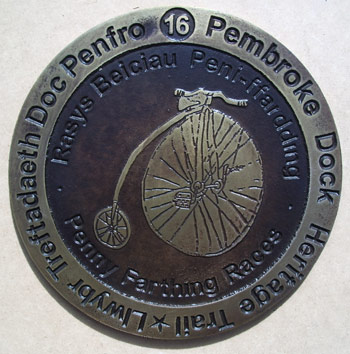 |
|
| 17. Llongau
Tanfor Y Rhyfel Byd Cyntaf - WW1 Submarines
In addition to the many ships that have been built
here in the dockyard, the Whitehouse torpedo sheds remind us of
the many submarines that were constructed here during the First
World War. They included the unlucky L10 which had been built
in Pembroke Dock in 1918. Whilst undergoing sea trails off St
Ann’s Head, the submarine hit the bottom and failed to surface.
News of her plight soon reached the dockyard and anxious onlookers
waited for her return in the wind and rain. Eventually, after
many hours and much to the relief of everyone, it managed to resurface. |
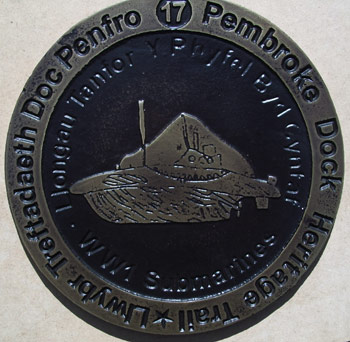 |
|
| 18. Balwnau
Amddiffyn – Barrage Balloons
This is the site of one of the many Barrage Balloons
that were tethered throughout the town during World War Two. One
of those in Pennar created some minor havoc when it broke free
from its mooring by St Patricks Church and proceeded to float
over Bufferland. It knocked off many chimney pots before it could
be recovered. |
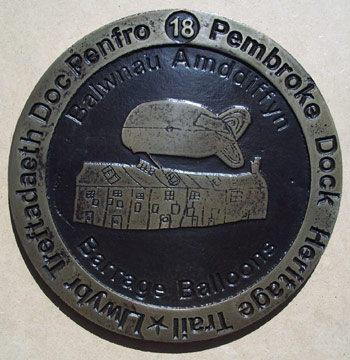 |
|
| |
||
| 19. Y Capten
Watkin Owen Pell – Captain Watkin Owen Pell
One of the most colourful Dockyard supervisors
during the 19th Century was Captain Watkin Owen Pell. He lost
his leg in action against the French in 1800 and adopted a wooden
replacement. A strict disciplinarian, the Captain would check
the work of his men by spying through a telescope from the top
of Barrack Hill. His donkey, on which he toured the Dockyard,
was trained so well, it would carry him up the gangways onto the
decks of the ships under construction. |
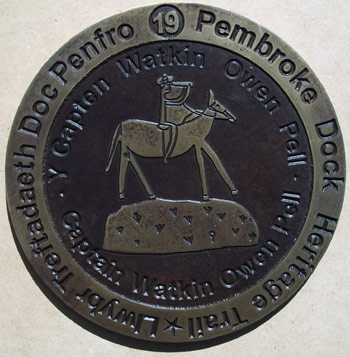 |
|
| 20. Barics Amddiffynadwy
– Defensible Barracks
A scheduled II listed building, The Defensible
barracks was built to defend the dockyard from a land attack.
The building was started in 1841 and completed in 1846. It is
claimed that the barracks’ overall design was influenced
by 16th Century Italian style fortifications. Originally the barracks
were known as Treowen Barracks and from here, twice a day, a cannon
firing a blank charge would alert town residents lacking watches
that it was either noon or nine thirty in the evening. The 9.30
signal became recognised as the curfew for local girls ‘out
courting.’ The noon day and evening guns rang out for the
last time in the 1920’s. |
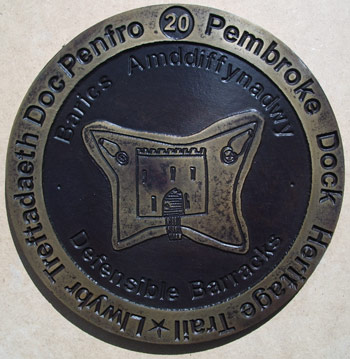 |
|
| 21 Tan Tanc
Olew – Oil Tank Fire
The Admiralty built a range of huge oil tanks
on this site at Llanreath in 1927. During the War, these tanks
were attacked by three German planes on Monday August 19th 1940.
The fire that ensued was one of the greatest infernos of the war.
It raged for three weeks and was fought by 650 firemen from brigades
all over the country. 11 of the 17 tanks were completely destroyed
and five fire fighters from Cardiff lost their lives. A memorial
to them is to be found in the middle of the Golf Course. |
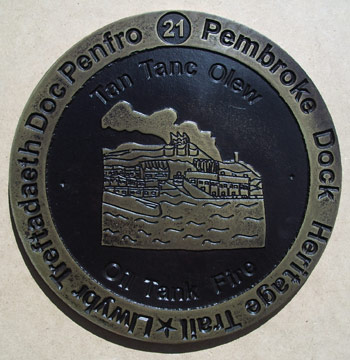 |
|
| |
||
| 22. Ffrwydrynnau
Tanfor – Submarine Mines
The Government constructed a torpedo store and
magazine close to the shore near Pennar Mouth in 1875. Torpedo
trails and submarine mining experiments, unique in Wales, were
carried out there. The site was also used to store all the equipment
necessary to mine the whole of the Haven. |
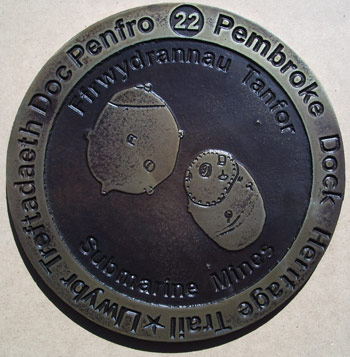 |
|
| |
||
| 23. Cwch Fferi
– Ferry Boat
The Bentlass to Pennar ferry boat service was
a major way for farmers’ wives to bring their produce to
market in Pembroke Dock. Workers who lived on the other side of
the Pembroke River also used it. |
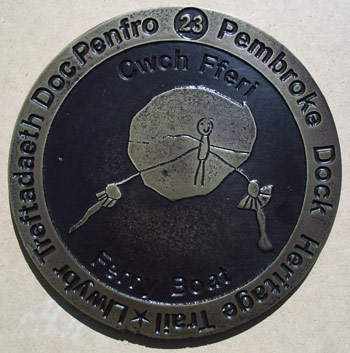 |
|
| |
||
| 24. Jacobs Pill
– Jacobs Pill
Sir Edward Reed established Jacob’s Pill
Boat Yard in the 1874 as a rival to the Royal Dockyard. After
becoming elected MP for Pembroke Borough, he fulfilled his promise
of creating a shipyard, offering many jobs recently made redundant
workers. Sir Edward Reed, who had a hand in designing the Royal
yacht Osborne, was a prolific boat designer. Perhaps the most
famous ship built here was The Hiei, a Corvette built for the
Japanese Navy and launched in 1877. By the end of the 19th Century,
the yard closed and between the two World Wars an Isolation Hospital
was established here. |
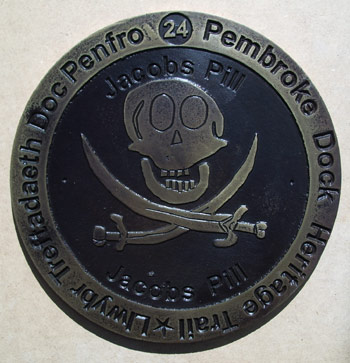 |
|
| |
||
| 25 Capel Bethania
– Bethany Chapel
With the inception of the Dockyard and the rapid
growth of the new town of Pembroke Dock, churches and chapels
sprung up to satisfy the growing demands of the town’s worshippers.
First off the mark were the Baptists who built Bethany Chapel
in 1818. They were the first Christian organisation in Pembroke
Dock to build a place of worship. Constructed using voluntary
labour, the original building had a seating capacity of 350. |
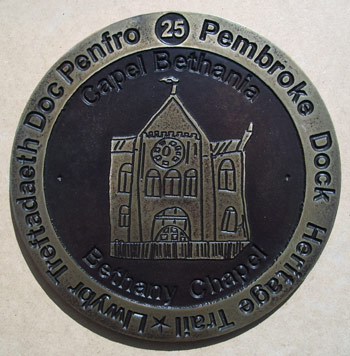 |
|
| |
||
| 26. Neuadd y
Farchnad – The Market Hall
The Market Hall was built in 1826 and purchased
by the Borough Council in 1881. The whole site was recently renovated
with the help of a heritage Lottery grant Weekly variety shows
were once held in the former courthouse. |
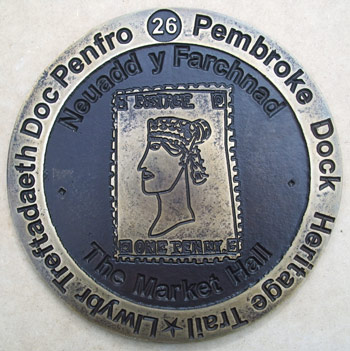 |
|
| |
||
| 27. Ysgol Sgwâr
Albion – Albion Square School
Albion Square was the hub of Pembroke Dock. The
first Co-op opened here in 1893 and, in nearby Charlton Terrace,
was the County Police Headquarters, jail and pound. |
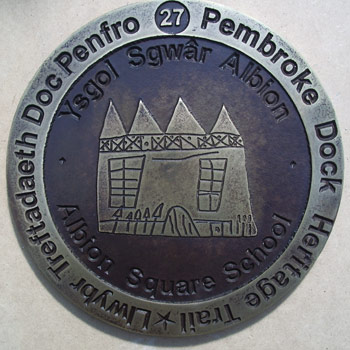 |
|
| |
||
| 28. Bysiau Deulawr - Double Deckers | 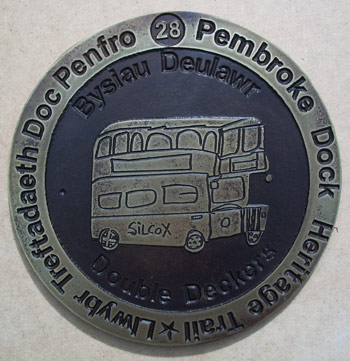 |
|
| |
||
| 29. Eglwys Gatholig
Y Santes Fair – St Mary’s RC Church
Reputedly, Catholic dockyard workers, many of
who were Irish immigrants escaping famine, each chipped in a day’s
pay every month in order to build St Mary’s in 1847. Some
of them provided unpaid labour in its construction. Of interest
are the stained glass windows that adorn the eastern wall which
were erected in 1926. Buried alongside t5he church by special
dispensation, is the grave of Father Oliver Murpthy who served
St Mary’s as its parish priest for 44 years. |
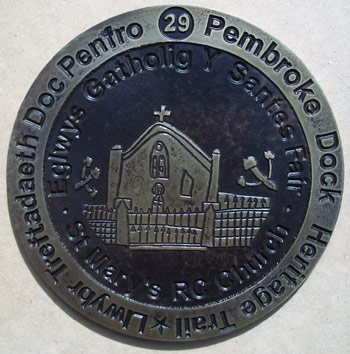 |
|
| |
||
| 30. Eglwys Rydd
Seion – Zion Free Church
This beautiful building was once a Wesleyan Chapel.
It was built using compensation money received when the Methodists
former chapel had to demolished because it stood within a specified
distance to the projected Defensible Barracks site. |
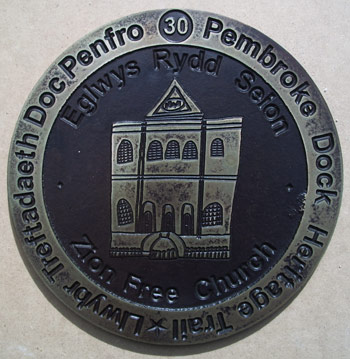 |
|
| |
||
| 31. Sinema’r Grand – Grand Cinema | 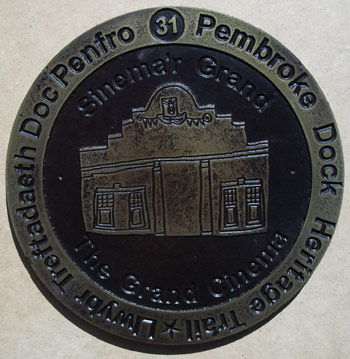 |
|
| |
||
| 32. Neuadd Pater
– Pater Hall
The Pater Hall was built on the site of the town’s
Temperance Hall, which was destroyed by bombing during World War
Two. It was said that when the bombs exploded, the main doors
of the building flew out and its ornate key was later recovered
in Front Street! |
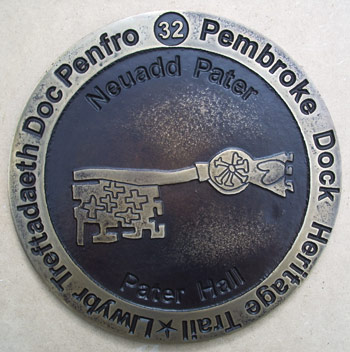 |
|
| |
||
| 33. Capel Bethel
– Bethel Chapel
When a dissident group from Bethany Chapel’s
congregation wanted a separate church, they built Bethel Chapel
here in 1844. This neo-gothic building, with its 400 seats, had
to be re-built in 1872 after a violent gale ripped off part of
its roof. |
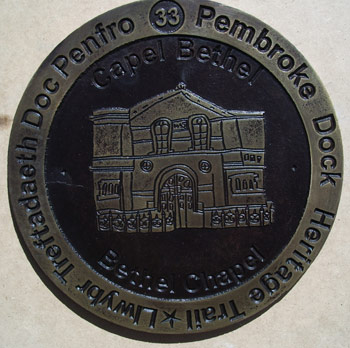 |
|
| |
||
| 34. Canolfan
y Coroni – Coronation Centre
It is said that because of dissension due to the
influence of the Church in the Victoria Road National School that
the Meyrick Street Old Brritish School was founded. In 1901, this
school was demolished and in 1904 it was replaced by the building
we see today, the Coronation Boys School. |
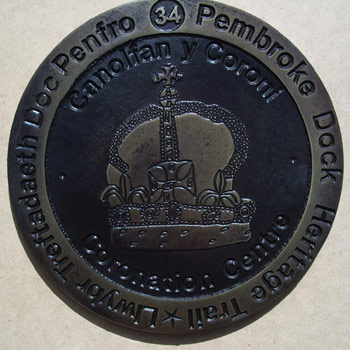 |
|
| |
||
| 35. Eglwys Blwyf
Sant Ioan – St John’s Parish Church
St John’s parish Church was built in 1847.
The 13th Century churches at Tenby and Castlemartin influenced
its overall design. This church has fifteen stained glass windows
designed by C.E. Kemp and in the Lady Chapel are beautiful examples
of carved reredos. One should also note the carved screen that
serves as a memorial to the men of the King’s Own Light
Infantry who had been stationed at Pembroke Dock during the First
World War. In addition, at the rear of the church, there is a
memorial board listing the names of all those service men from
Pembroke Dock who lost their lives in the Second World War. |
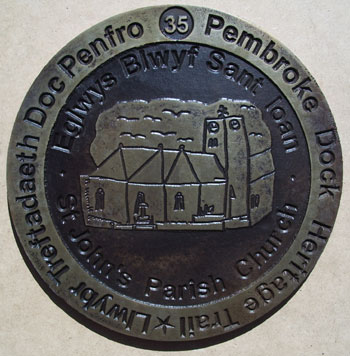 |
|
| |
||
| 36. Eglwys Sant
Andreas – St Andrew’s Parish Church
Built in an Italian Gothic style in grey squared
limestone with prominent red brick and Bath stone features, this
building was established in 1866. St Andrews Presbyterian Churchhas
three beautiful stained glass windows, unusual for a Nonconformist
church and its large basement that served as a Sunday school could
seat 750 children! |
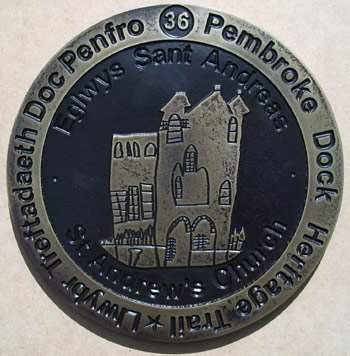 |
|
| |
||
| 37. Y Parc Coffa
– Memorial Park
The Memorial Park opened in 1925 and commemorates
the “fallen heroes of Pembroke Dock who gave their lives
in the 1914-18 Great War.” |
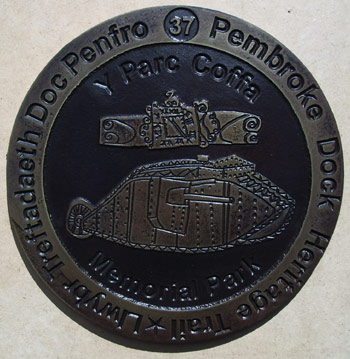 |
|
| |
||
| 38. W. Haggar
– Arloeswr y Sinema – W. Haggar – Pioneer of Cinema
Arthur William Haggar (1851-1925) was a true pioneer
of cinema. He was also a showman and fairground proprietor. He
and his large family travelled throughout Britain bringing entertainment
to the people. Here at Station Field his Electric Bioscope, waxworks
and theatrical shows regular took place to entertain the people
of Pembroke Dock. His grandson, Len Haggar later ran cinemas in
Pembroke, Milford Haven, Cardigan and Pembroke Dock. |
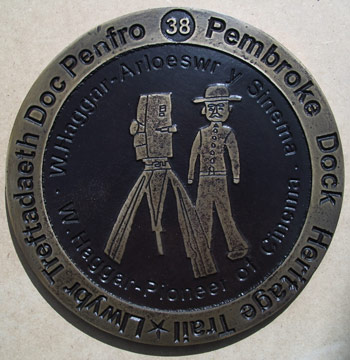 |
|
| 39. Gorsaf Reilffordd
– Railway Station
Pembroke Dock stationed opened in 1864, offering
a free ride to Tenby on its inaugural journey. The railway line
cut through the town into the dockyard. A secondary spur leading
to Hobbs Point followed in the 1870’s. Haggar’s 1908
film The Life and Death of Charles Peace used the station as its
main location. Not only was the film the first ‘chase’
movie ever made, predating the more famous Keystone Cops films
by a number of years, it was also the first film to show a death
scene. Based on a true story, the film was a huge sensation and
made the Haggar family very wealthy. |
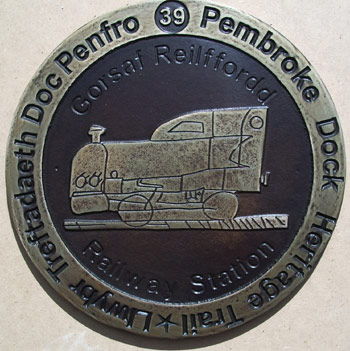 |
|
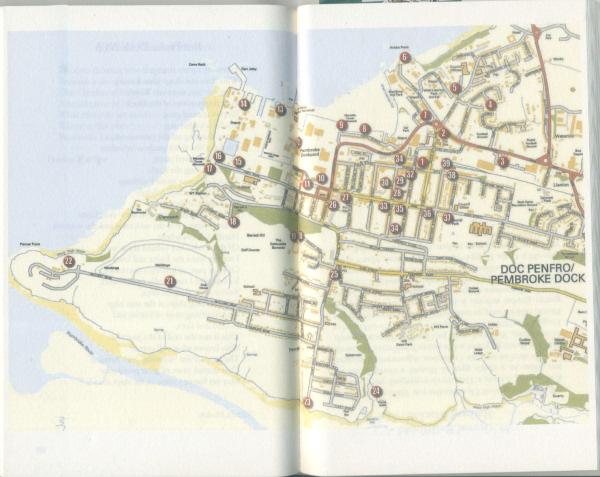 |
||
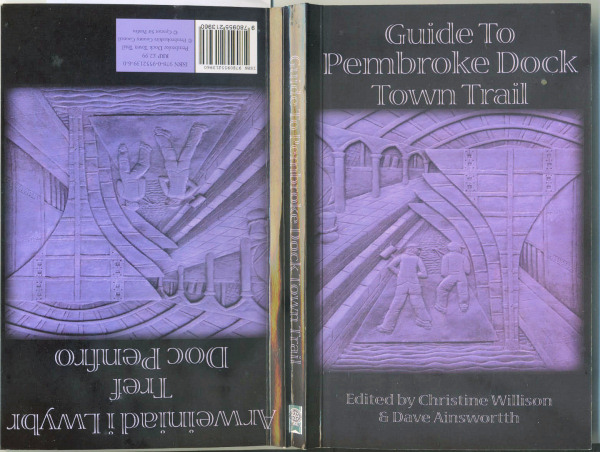 |
||
Acknowledgements;
Pembroke Dock Townscape Heritage Initiative Children and Staff of; Albion Square School Pennar Junior School Pennar Infants School Community School St Mary’s RC School Bush Comprehensive School John Williams of Silcox David James John Davies Ron Watts R Haggar etc |
||
| Back to the top | ||
